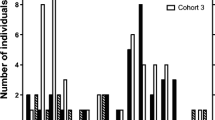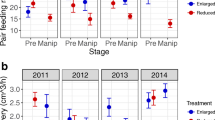Summary
Prairie vole (Microtus ochrogaster) family groups were examined to determine possible indirect fitness benefits from the presence of juvenile helpers at the natal nest. The reproductive performance of family groups retaining two juveniles was compared with that of families in which all juveniles were removed when the subsequent litter was born. Litter sizes at birth of the second litter and pup survival rates were the same in the two treatments. Offspring quality was affected by the presence of juveniles however. Pups reared with juveniles weighed 13% more at weaning than pups reared without juveniles. Pups also opened their eyes sooner when juveniles were present. Differences in growth and development may have been affected by the amount of time pups were alone in the nest since pups in families with juveniles were left alone less frequently than were pups without juveniles. Maternal behavior patterns were not affected by the presence of juveniles. In contrast, fathers in families with juveniles spent more time in non-parental behaviors such as feeding, drinking, and foraging. In families with large litters, mothers delivered a subsequent litter sooner if juveniles were present. Subsequent litter sizes were the same in both treatments. Overall, both infants and parents benefited from the presence of juveniles, suggesting that helping may enhance the helper's indirect fitness in multiple ways.
Similar content being viewed by others
References
Austad SN, Rabenold KN (1985) Reproductive enhancement by helpers and an experimental inquiry into its mechanism in the bicolored wren. Behav Ecol Sociobiol 17:19–27
Boonstra R, Krebs CJ, Beacham TD (1980) Impact of botfly parasitism on Microtus townsendii populations. Can J Zool 58:1683–1692
Brown JL (1974) Alternative routes to sociality in jays. With a theory for the evolution of altruism and communal breeding. Am Zool 14:63–80
Brown JL (1987) Helping and communal breeding in birds. Princeton University Press, Princeton, NJ
Brown JL, Brown ER (1981) Kin selection and individual selection in babblers. In: Alexander RD, Tinkle DW (eds) Natural selection and social behavior. Chiron, New York, pp 244–256
Brown JL, Brown ER, Brown SD, Dow DD (1982) Helpers: effects of experimental removal on reproductive success. Science 215:421–422
Carter CS, Getz LL (1985) Social and hormonal determinants of reproductive patterns in the prairie vole. In: Gilles R, Balthazart J (eds) Neurobiology. Springer, Berlin Heidelberg New York, pp 18–36
Cole FR, Batzli GO (1979) Nutrition and population dynamics of the prairie vole, Microtus ochrogaster, in central Illinois. J Anim Ecol 48:455–470
Coopersmith CB, Huck UW, Conant-Huck L, Banks EM (1986) Effects of pre- and postpubertal social experience on sexual and social behavior in male and female brown lemmings (Lemmus sibericus). J Comp Psychol 100:406–412
Cotton MJ, Griffiths DA (1967) Observations on temperature conditions in vole nests. J Zool Lond 153:541–544
Elwood RW, Broom DM (1978) The influence of litter size and parental behaviour on the development of Mongolian gerbil pups. Anim Behav 26:438–454
Emlen ST (1978) The evolution of cooperative breeding in birds. In: Krebs JR, Davies NB (eds) Behavioural ecology. Sinauer, Sunderland, MA, pp 245–281
Emlen ST, Wrege PH (1988) The role of kinship in helping decisions among white-fronted bee-eaters. Behav Ecol Sociobiol 23:305–315
Fedyk A (1971) Social thermoregulation in Apodemus flavicollis (Melchior, 1834). Acta Theriol 16:221–229
Fried JJ (1987) The role of juvenile pine voles (Microtus pinetorum) in the caretaking of their younger siblings. Master's thesis, North Carolina State University, Raleigh
Friedman MI, Bruno JP, Alberts JR (1981) Physiological and behavioral consequences in rats of water recycling during lactation. J Comp Physiol Psych 95:26–35
Fuchs S (1982) Optimality of parental investment: The influence of nursing on reproductive success of mother and female young house mice. Behav Ecol Sociobiol 10: 39–51
Gebczynska Z, Gebczynski M (1971) Insulating properties of the nest and social temperature regulation in Clethrionomys glareolus (Schreber). Ann Zool Fenn 8:104–108
Getz LL, Hofmann JE (1986) Social organization in free-living prairie voles, Microtus ochrogaster. Behav Ecol Sociobiol 18:275–282
Getz LL, Hofmann JE, Carter CS (1987) Mating system and population fluctuations of the prairie vole, Microtus ochrogaster. Am Zool 27:909–920
Getz LL, Solomon NG, Pizzuto TM (1990) The effects of predation of snakes on social organization of the prairie vole, Microtus ochrogaster. Am Midl Nat 123:365–371
Gibbons DW (1987) Juvenile helping in the moorhen, Gallinula chloropus. Anim Behav 35:170–181
Glaser H, Lustick S (1975) Energetics of nesting behavior of the northern white-footed mouse, Peromyscus leucopus novaboracensis. Physiol Zool 48:105–113
Glass AR, Swerdloff RS (1980) Nutritional influences on sexual maturation in the rat. Fed Proc 39:2360–2364
Gruder-Adams S, Getz LL (1985) Comparison of the mating system and paternal behavior in Microtus ochrogaster and M. pennsylvanicus. J Mammal 66:165–167
Gubernick DJ, Alberts JR (1983) Maternal licking of young: Resource exchange and proximate controls. Physiol Behav 31:593–601
Hard E, Larssonza K (1968) Dependence of adult mating behavior in male rats on the presence of littermates in infancy. Brain Behav Evol 1:405–419
Hasler JF (1975) A review of reproduction and sexual maturation in the microtine rodents. Biologist 57:52–86
Howell DC (1982) Statistical methods for psychology. Duxbury Press, Boston, MA
Hrdy SB (1976) Care and exploitation of nonhuman primate infants by conspecifics other than the mother. Adv Study Behav 6:101–158
Huck UW, Labov JR, Lisk RD (1986) Food restricting young hamsters (Mesocricetus auratus) affects sex ratio and growth of subsequent offspring. Biol Reprod 35:592–598
Huck UW, Labov JB, Lisk RD (1987) Food restricting first generation juvenile female hamsters (Mesocricetus auratus) affects sex ratio and growth of third generation offspring. Biol Reprod 37:612–617
Keller B (1985) Reproductive patterns. In: Tamarin RH (ed) Biology of new world Microtus. American Society of Mammalogists, pp 725–778
Kirk RE (1982) Experimental design: Procedures for the behavioural sciences, 2nd edn. Brooks/Cole Publ Co, Monterey, CA
Kleiman D (1977) Monogamy in mammals. Q Rev Biol 52:39–69
Koenig W (1981) Reproductive success, group size, and the evolution of cooperative breeding in the acorn woodpecker. Am Nat 117:421–443
Lancaster JB (1971) Play mothering: The relations between juvenile females and young infants among free-ranging vervet monkeys, Cercopithecus aethiops. Folia Primatol 15:161–182
Lennartz MR, Hooper RG, Harlow RF (1987) Sociality and cooperative breeding of red-cockaded woodpeckers, Picoides borealis. Behav Ecol Sociobiol 20:77–88
Ligon JD (1981) Demographic patterns and communal breeding in the green woodhoopoe, Phoeniculus purpureus. In: Alexander RD, Tinkle DW (eds) Natural selection and social behavior. Chiron Press, New York, pp 231–243
Machin D, Page S (1973) Effects of reduction of litter size on subsequent growth and reproductive performance in mice. Anim Prod 16:1–6
Martin P, Bateson P (1986) Measuring behaviour. Cambridge University Press, Cambridge
Mattingly DK, McClure PA (1985) Energy allocation during lactation in cotton rats (Sigmodon hispidus) on a restricted diet. Ecology 66:928–937
McGuire B, Pizzuto T, Getz LL (1990) Potential for social interaction in a natural population of prairie voles (Microtus ochrogaster). Can J Zool 68:391–398
Miller JLS (1974) Energy requirements for growth in Microtus ochrogaster. Master's thesis, Colorado State University, Fort Collins
Moehlman PD (1979) Jackal helpers and pup survival. Nature 277:382–383
National Oceanic and Atmospheric Administration (1981–1984) Climatological data. Annual Summary Illinois Dept. Commerce
Ostermeyer MC, Elwood RW (1984) Helpers (?) at the nest in the Mongolian gerbil, Meriones unguiculatus. Behaviour 91:6177
Ota K, Yokoyama A (1967) Body weight and food consumption of lactating rats nursing various sizes of litters. J Endocrinol 38:263–268
Parry V (1973) The auxiliary social system and its effect on territory and breeding in kookaburras. Emu 73:81–100
Peeling AN, Looker T (1987) Problem of standardizing growth rates for animals suckled in separate litters. Growth 51:165–169
Rood JP (1990) Group size, survival, reproduction, and routes to breeding in dwarf mongooses. Anim Behav 39: 566–572
Rowley I (1965) The life history of the superb blue wren. Emu 64:251–297
Salo AL, French JA (1989) Early experience, reproductive success, and development of parental behaviour in Mongolian gerbils. Anim Behav 38:693–702
Schanberg SM, Evoniuk G, Kuhn CM (1984) Tactile and nutritional aspects of maternal care: Specific regulators of neuroendocrine function and cellular development. Proc Soc Exp Biol Med 175:135–146
Solomon NG (1991) Indirect fitness benefits to philopatric juvenile prairie voles, Microtus ochrogaster. PhD thesis, University of Illinois, Urbana-Champaign
Thomas JA, Birney EC (1979) Parental care and mating system of the prairie vole, Microtus ochrogaster. Behav Ecol Sociobiol 5:171–186
Trojan P, Wojciechowska B (1968) The effect of huddling on the resting metabolism rate of the European common vole Microtus arvalis (Pall). Bull de l'academie polonaise des sciences, CL. II-16:107–109
Williams JPG, Hughes PCR (1975) Catch-up growth in rats undernourished for different periods during the suckling period. Growth 39:179–193
Woolfenden GE (1981) Selfish behavior by Florida scrub jay helpers. In: Alexander RD, Tinkle DW (eds) Natural selection and social behavior. Chiron Press, New York, pp 257–260
Author information
Authors and Affiliations
Rights and permissions
About this article
Cite this article
Solomon, N.G. Current indirect fitness benefits associated with philopatry in juvenile prairie voles. Behav Ecol Sociobiol 29, 277–282 (1991). https://doi.org/10.1007/BF00163985
Received:
Accepted:
Issue Date:
DOI: https://doi.org/10.1007/BF00163985




